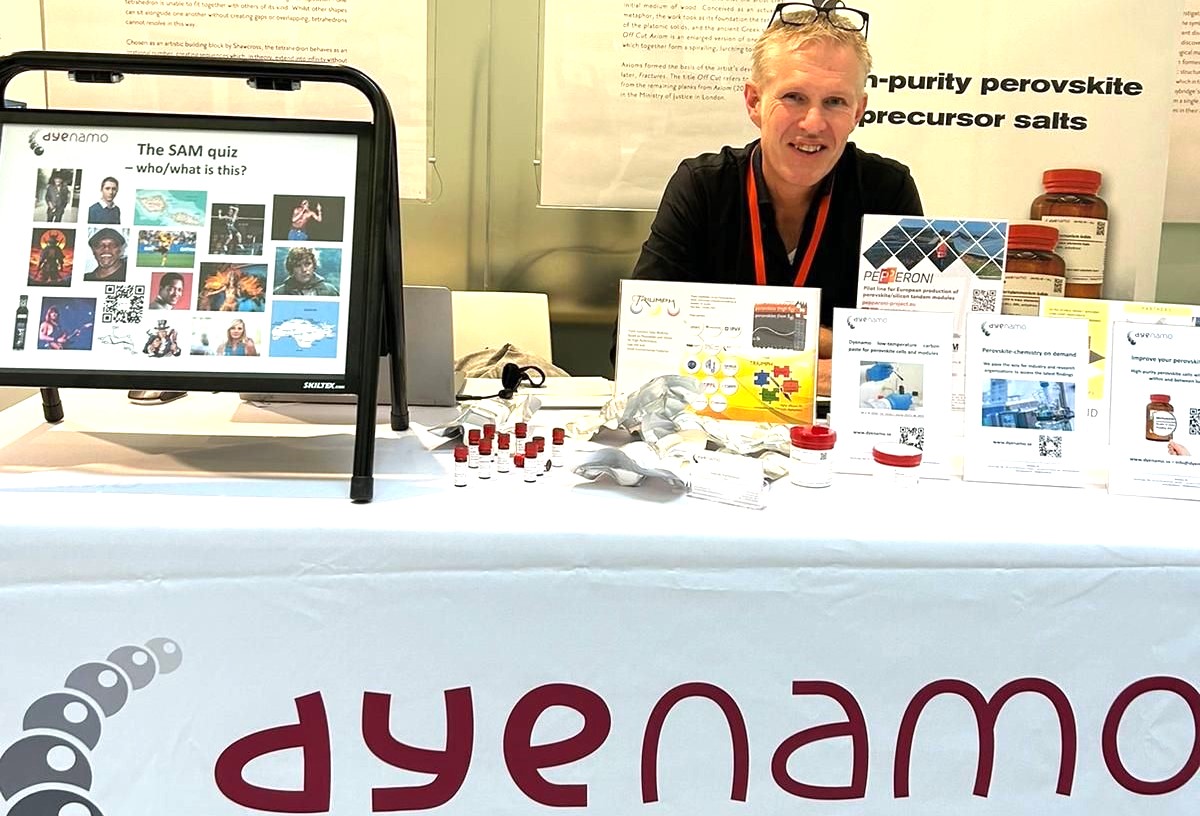Dyenamo, a Swedish manufacturer of solar cell materials, has expanded the range and the volume of production of its perovskite materials with the addition of five new fullerene acceptors.
“The main reason for launching the new products was to supply emerging perovskite-silicon tandem solar cell manufacturers. They need high-purity perovskite salts, self-assembled monolayer molecules, acceptor materials, and passivation materials,” the company's CEO, Henrik Pettersson, told pv magazine.
The fullerene acceptor materials are typically used in organic PV (OPV) and perovskite solar cells for electron transport, and they are compatible with both vacuum and solution processing. The range includes buckminsterfullerene (C60), C70, phenyl-C61-butyric acid methyl ester (PCBM), PC71BM and ICBA.
The new line is just the latest expansion news from the Swedish company. A few months earlier, Dyenamo added a line of perovskite passivation products and a line of self-assembled monolayer (SAM) molecular materials to its range of perovskite materials.
Dyenamo has been supplying the chemistry-based solar cell industry since 2011. Its perovskite materials have been used in record-breaking devices for their stabilizing effects or efficiency-enhancing performance, or both, according to Dyenamo CEO, Henrik Pettersson.
“Last year, we increased production of high-quality perovskite salts and low-temperature carbon paste following our customers’ need to continue to modify the properties of their devices,” said Henrik who added that customers are located in Europe, North America, Asia, and Australia.
The Dyenamo salts are used in the range of perovskite concepts and deposition techniques, vacuum and solutions-based, while the carbon paste is particularly useful in so-called inverse n-i-p perovskite cells that have carbon as the back-contact material.
Popular content
As for the passivation materials, Pettersson highlighted how they contribute to device stability without being detrimental to efficiency values. The passivation layers typically enhance the hydrophobicity of the perovskite surface working against moisture and passivate defects. They prolong charge-carrier lifetimes and suppress non-radiative recombination losses. “By engineering the interfaces within perovskite devices, they are creating more favorable energy level alignments and enhancing charge extraction, as well as reducing charge recombination. In addition, they inhibit ion migration,” said Pettersson.
Dyenamo, which currently employs 10 professionals, initially targeted dye-sensitized solar cell (DSSC) materials. “The focus was due to our founders’ research and development experience but after two years of supplying DSSC material, we added perovskite in 2013. There is an overlap in the materials used,” said Pettersson. “Later, we added the OPV customer base for the same reason, that is, certain perovskite materials are applicable to OPV fabrication.”
To keep pace with the latest research and development trends, Dyenamo is active in four European perovskite projects; Pepperoni, a four-year research project involving a pilot line at Qcells in Germany; Triumph, a project aiming for triple-junction silicon-perovskite-perovskite devices coordinated by IMEC; the Diamond project which has a focus on carbon back-contact devices, coordinated by the Fraunhofer ISE; and Sunrey, a project coordinated by Fraunhofer Institute for Applied Polymer Research (IAP) working on processes and materials to fabricate high efficiency, lead-free perovskite devices, as well as Swedish projects that target key challenges.
“This kind of collaboration is important. There are so many records being broken and advances being made in terms of device sizes, lifetimes and stability, PV stack configurations, indoor PV, high temperature processing and solutions processing. It is still not clear which will be the winning combinations,” said Pettersson.
This content is protected by copyright and may not be reused. If you want to cooperate with us and would like to reuse some of our content, please contact: editors@pv-magazine.com.


By submitting this form you agree to pv magazine using your data for the purposes of publishing your comment.
Your personal data will only be disclosed or otherwise transmitted to third parties for the purposes of spam filtering or if this is necessary for technical maintenance of the website. Any other transfer to third parties will not take place unless this is justified on the basis of applicable data protection regulations or if pv magazine is legally obliged to do so.
You may revoke this consent at any time with effect for the future, in which case your personal data will be deleted immediately. Otherwise, your data will be deleted if pv magazine has processed your request or the purpose of data storage is fulfilled.
Further information on data privacy can be found in our Data Protection Policy.